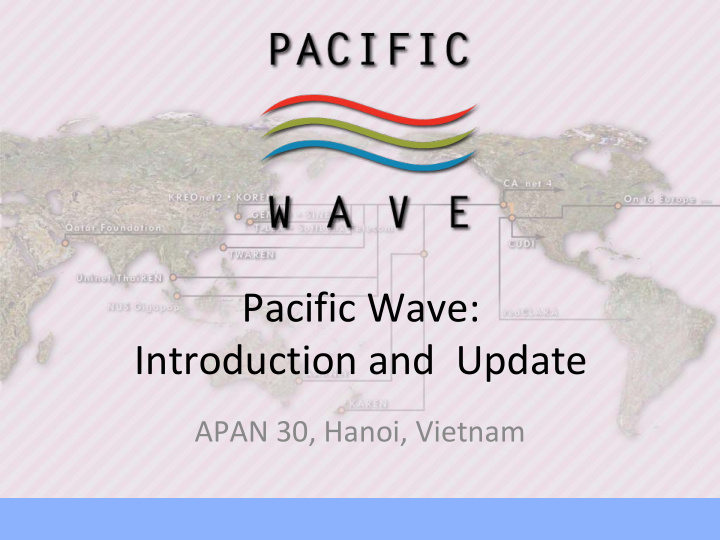



Pacific Wave: Introduction and Update APAN 30, Hanoi, Vietnam
What is Pacific Wave? • It is a state ‐ of ‐ the ‐ art international peering exchange facility designed to serve research and education networks throughout the Pacific Rim and the world. • It is a distributed exchange allowing participants at any of its connection points to interconnect in a transparent way. • It is flexible, adaptable, and able to leverage rapidly changing technologies to meet the diverse needs of different networks. • Pacific Wave is a joint project between the Corporation for Education Network Initiatives in California (CENIC) and the Pacific Northwest Gigapop (PNWGP) and is operated in collaboration with the University of Southern California and the University of Washington. 2 Pacific Wave International Distributed Peering Facility • www.pacificwave.net
Pacific Wave: A brief overview • In 2004, Seattle and Los Angeles exchanges were connected to form Pacific Wave using waves from National Lambda Rail (NLR), CENIC, and PNWGP. • Taking advantage of submarine cabling landings along the Pacific coast, Pacific Wave is available in: – Seattle , Washington (1 site), Los Angeles, California (3 sites), and Sunnyvale/Palo Alto, California (2 sites) • It is the longest operating distributed internet exchange. • Currently 26 networks exchange traffic on Pacific Wave, including R&E Networks from Asia, Oceania, the Middle East, South America, and North America. 3 Pacific Wave International Distributed Peering Facility • www.pacificwave.net
More than just a Layer 2 exchange • Pacific Wave supports: – Network ‐ to ‐ network Layer 3 peering across regional and inter ‐ regional public VLANS. – Dedicated VLANs between participants for traffic exchange at Layer 2. – Access to Dynamic Circuit Networks (Internet2 ION, NLR Framenet). – Lightpath and VLAN provisioning via GLIF. 4 Pacific Wave International Distributed Peering Facility • www.pacificwave.net
VLANS 5 Pacific Wave International Distributed Peering Facility • www.pacificwave.net
Pacific Wave Exchange Switches 6 Pacific Wave International Distributed Peering Facility • www.pacificwave.net
Have you seen this map (GLIF)? 7 Pacific Wave International Distributed Peering Facility • www.pacificwave.net
GLIF Map Acknowledgements Acknowledgements ‐ The Global Lambda Integrated Facility (GLIF) Map 2008 • visualization was created by Robert Patterson of the Advanced Visualization Laboratory (AVL) at the National Center for Supercomputing Applications (NCSA) at the University of Illinois at Urbana ‐ Champaign (UIUC), using an Earth image provided by NASA. Data was compiled by Maxine D. Brown of the Electronic Visualization Laboratory (EVL) at the University of Illinois at Chicago (UIC). Funding was provided by GLIF and US National Science Foundation grants # SCI ‐ 04 ‐ 38712 to NCSA/UIUC and # OCI ‐ 0441094 to EVL/UIC. For more information on GLIF, see http://www.glif.is/. Additional Information ‐ The GLIF map does not represent all the world's Research • and Education optical networks, and does not show international capacity that is dedicated to production usage. The GLIF map only illustrates excess capacity that its participants are willing to share with international research teams for applications ‐ driven and computer ‐ system experiments, in full or in part, all or some of the time. GLIF does not provide any network services itself, and researchers should approach individual GLIF network resource providers to obtain lightpath services. 8 Pacific Wave International Distributed Peering Facility • www.pacificwave.net
GLIF Open Lambda Exchange (GOLE) Pacific Wave is a participant in the Global Lambda Integrated Facility (GLIF) – an international virtual organization. Pacific Wave operates three GOLEs, one in each of its three points of presence. 9 Pacific Wave International Distributed Peering Facility • www.pacificwave.net
Seattle GOLE 10 Pacific Wave International Distributed Peering Facility • www.pacificwave.net
Los Angeles GOLE 11 Pacific Wave International Distributed Peering Facility • www.pacificwave.net
Sunnyvale (Palo Alto) GOLE 12 Pacific Wave International Distributed Peering Facility • www.pacificwave.net
Pacific Wave GOLE (Detailed View) 13 Pacific Wave International Distributed Peering Facility • www.pacificwave.net
Pacific Wave supports research and education. • Telemedicine • Remote collaborations • Collaborative arts • Global visualcasting • Student exchange (MURPA/UCSD Prime) • Large volume data transfer over networks • Remote instrumentation & data visualization • Digital archives 14 Pacific Wave International Distributed Peering Facility • www.pacificwave.net
Without borders • Music • Arts • Education/Teaching • Medicine • Astronomy • Ocean Sciences 15 Pacific Wave International Distributed Peering Facility • www.pacificwave.net
Astronomy: eVLBI, eVLBA Pacific Wave supports e ‐ Very Long Baseline Interferometry (eVLBI) and e ‐ Very Long Baseline Array applications (eVLBA) 16 Pacific Wave International Distributed Peering Facility • www.pacificwave.net
High Energy Physics • HEP – Atlas – Belle – Alice – CMS – Ultralight 17 Pacific Wave International Distributed Peering Facility • www.pacificwave.net
Ocean Observatories Initiative The Ocean Observatories Initiative (OOI) will construct a networked infrastructure of science ‐ driven sensor systems to measure the physical, chemical, geological, and biological variables in the ocean and seafloor. Greater knowledge of these variables is vital for improved detection and forecasting of environmental changes and their effects on biodiversity, coastal ecosystems, and climate. 18 Pacific Wave International Distributed Peering Facility • www.pacificwave.net
Future Directions: • Additional backbone capacity. • PerfSONAR and other network/performance measurements. • 40 Gigabit, 100 Gigabit. • Dynamic VLAN provisioning. • Support of Future Internet activities. 19 Pacific Wave International Distributed Peering Facility • www.pacificwave.net
For more information • See the website at www.pacificwave.net. • Contact info@pacificwave.net. • Contact: – Celeste Anderson celestea@pacificwave.net or celestea@usc.edu (California). – Jan Eveleth eveleth@pacificwave.net (Washington). 20 Pacific Wave International Distributed Peering Facility • www.pacificwave.net
Recommend
More recommend